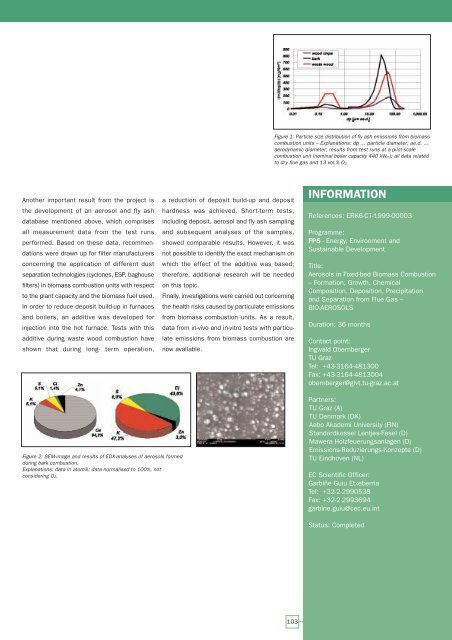European Bio-Energy Projects
European Bio-Energy Projects
European Bio-Energy Projects
Create successful ePaper yourself
Turn your PDF publications into a flip-book with our unique Google optimized e-Paper software.
Another important result from the project is<br />
the development of an aerosol and fly ash<br />
database mentioned above, which comprises<br />
all measurement data from the test runs<br />
performed. Based on these data, recommendations<br />
were drawn up for filter manufacturers<br />
concerning the application of different dust<br />
separation technologies (cyclones, ESP, baghouse<br />
filters) in biomass combustion units with respect<br />
to the plant capacity and the biomass fuel used.<br />
In order to reduce deposit build-up in furnaces<br />
and boilers, an additive was developed for<br />
injection into the hot furnace. Tests with this<br />
additive during waste wood combustion have<br />
shown that during long- term operation,<br />
Figure 2: SEM-image and results of EDX-analyses of aerosols formed<br />
during bark combustion.<br />
Explanations: data in atom%; data normalised to 100%, not<br />
considering O2.<br />
a reduction of deposit build-up and deposit<br />
hardness was achieved. Short-term tests,<br />
including deposit, aerosol and fly ash sampling<br />
and subsequent analyses of the samples,<br />
showed comparable results. However, it was<br />
not possible to identify the exact mechanism on<br />
which the effect of the additive was based;<br />
therefore, additional research will be needed<br />
on this topic.<br />
Finally, investigations were carried out concerning<br />
the health risks caused by particulate emissions<br />
from biomass combustion units. As a result,<br />
data from in-vivo and in-vitro tests with particulate<br />
emissions from biomass combustion are<br />
now available.<br />
Figure 1: Particle size distribution of fly ash emissions from biomass<br />
combustion units – Explanations: dp … particle diameter; ae.d. …<br />
aerodynamic diameter; results from test runs at a pilot-scale<br />
combustion unit (nominal boiler capacity 440 kWth); all data related<br />
to dry flue gas and 13 vol.% O2.<br />
103<br />
INFORMATION<br />
References: ERK6-CT-1999-00003<br />
Programme:<br />
FP5 - <strong>Energy</strong>, Environment and<br />
Sustainable Development<br />
Title:<br />
Aerosols in Fixed-bed <strong>Bio</strong>mass Combustion<br />
– Formation, Growth, Chemical<br />
Composition, Deposition, Precipitation<br />
and Separation from Flue Gas –<br />
BIO-AEROSOLS<br />
Duration: 36 months<br />
Contact point:<br />
Ingwald Obernberger<br />
TU Graz<br />
Tel: +43-3164-481300<br />
Fax: +43-3164-4813004<br />
obernberger@glvt.tu-graz.ac.at<br />
Partners:<br />
TU Graz (A)<br />
TU Denmark (DK)<br />
Aabo Akademi University (FIN)<br />
Standardkessel Lentjes-Fasel (D)<br />
Mawera Holzfeuerungsanlagen (D)<br />
Emissions-Reduzierungs-Konzepte (D)<br />
TU Eindhoven (NL)<br />
EC Scientific Officer:<br />
Garbiñe Guiu Etxeberria<br />
Tel: +32-2-2990538<br />
Fax: +32-2-2993694<br />
garbine.guiu@cec.eu.int<br />
Status: Completed

















